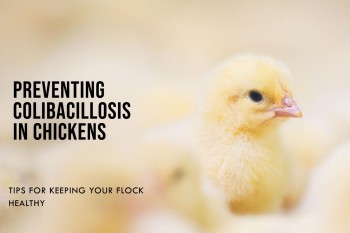Duckling Septicemia: Causes, Clinical Signs, Diagnosis, Treatment, and
Prevention 🦆🤒💉🔬
Duckling septicemia is a
significant health concern in the commercial rearing of ducklings, leading to
varying levels of morbidity and mortality during the initial weeks of the
brooding period. In this comprehensive article, we delve into the etiology,
clinical signs, pathology, diagnosis, treatment, and prevention strategies
associated with duckling septicemia. Aimed at veterinarians, this guide
provides valuable insights to effectively manage and prevent this condition.
Join us as we explore the world of 🦆🤒💉🔬
and gain in-depth knowledge about duckling septicemia.
Etiology:
Duckling septicemia primarily
arises from an infection caused by the bacterium Riemerella anatipestifer, a
gram-negative coccobacillus. This pathogen is capable of inducing severe
systemic infections in young ducklings. However, it is important to note that
concurrent infections can also contribute to the severity of the disease. These
may include infections such as Escherichia coli, septicemia, salmonellosis, and
duck virus hepatitis, which can further complicate the clinical presentation
and increase mortality rates.
Occurrence and Economic Significance:
Duck septicemia is a global
concern, occurring in all areas where ducklings are reared commercially. The
disease manifests itself during the first two weeks of the brooding period when
ducklings are most vulnerable. Morbidity and mortality rates can vary depending
on factors such as the virulence of the pathogen, environmental conditions, and
the overall health status of the ducklings. The economic impact of duckling
septicemia is substantial, as it can result in significant losses for duckling
producers. Reduced growth rates, increased treatment costs, and higher
mortality rates can all contribute to financial burdens within the industry.
Transmission:
The transmission of duckling
septicemia primarily occurs through direct contact of susceptible ducklings
with a contaminated environment. This can involve exposure to contaminated
bedding, water, or feed. Additionally, certain management factors, such as footpad
lesions caused by defective wire floors, can predispose ducklings to
percutaneous infection, increasing their susceptibility to the disease.
Contaminated equipment, personnel, or other infected waterfowl can also
contribute to the spread of the infection.
Clinical Signs:
Clinical signs of duckling
septicemia often manifest as a combination of systemic and respiratory
symptoms. Affected ducklings may display depression, lethargy, ataxia (loss of
coordination), ocular and nasal discharge, and respiratory rales. These signs
reflect the systemic involvement of the disease and the impact on the
respiratory system. In severe cases, ducklings may exhibit nervous signs, such
as convulsions or tremors, indicating the occurrence of fibrinous meningitis.
Mortality can be high, particularly in outbreaks with virulent strains of
Riemerella anatipestifer.
Pathology:
Pathological examination of
ducklings affected by septicemia reveals characteristic lesions. These include
perihepatitis (inflammation of the liver capsule), pericarditis (inflammation
of the heart sac), fibrinous airsacculitis (inflammation of the air sacs with
the formation of fibrin), hepatomegaly (enlargement of the liver), and
splenomegaly (enlargement of the spleen). These changes indicate the systemic
nature of the infection and the involvement of multiple organs. Additionally,
fibrinous meningitis may be observed in ducklings that display nervous signs,
indicating the presence of inflammation in the brain and meninges.
Diagnosis:
Accurate and timely diagnosis of
duckling septicemia is crucial for effective disease management. Diagnosis is
primarily based on the isolation and identification of Riemerella anatipestifer
from relevant tissues, such as heart blood, liver, or brain tissue. Culturing the
pathogen on appropriate culture media, such as blood agar or trypticase soy
agar, can facilitate its identification. Diagnostic laboratories may employ
additional tests, including biochemical tests and serological assays, to
confirm the presence of the pathogen and rule out other potential infectious
agents.
Treatment:
Treatment of duckling septicemia
primarily involves supportive therapy to help affected ducklings recover from
the systemic infection. Additionally, antimicrobial agents are administered to
target the causative bacteria and control the progression of the disease.
Water-soluble tetracycline is a commonly used antibiotic in the treatment of
duckling septicemia. Enrofloxacin, an effective fluoroquinolone, can also be
given through drinking water at specific dosage levels. The treatment protocol
should be developed in consultation with a veterinarian, taking into
consideration the severity of the infection, the susceptibility of the
pathogen, and the overall health status of the affected ducklings.
Prevention:
Prevention strategies play a
vital role in minimizing the occurrence and impact of duckling septicemia.
Effective management practices should be implemented, including proper
sanitation protocols between placements, avoiding overcrowding, and maintaining
optimal environmental conditions. Adequate ventilation, temperature control,
and biosecurity measures are crucial in preventing the spread of the infection.
Vaccination is also an important preventive measure. Multivalent or homologous
bacterins can be administered to ducklings at 1 to 2 weeks of age to stimulate
protective immunity. Furthermore, a live attenuated vaccine has been developed,
targeting serotypes 1, 2, and 5, and can be administered to day-old ducklings
via the aerosol route or through drinking water.
Duckling septicemia poses a
significant challenge in the commercial rearing of ducklings. Through
understanding its etiology, clinical signs, pathology, diagnosis, treatment,
and prevention strategies, veterinarians can play a crucial role in mitigating the
impact of this condition. By implementing effective management strategies,
employing appropriate treatment protocols, and integrating preventive measures,
we can combat 🦆🤒💉🔬
duckling septicemia and safeguard the future of duckling production.

















